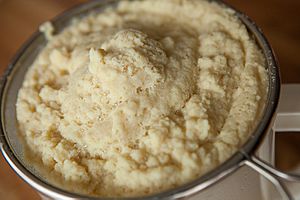Okara (food) facts for kids
Quick facts for kids Okara |
|||||||||
|---|---|---|---|---|---|---|---|---|---|

Filtering okara from a fresh batch of homemade soymilk.
|
|||||||||
| Chinese name | |||||||||
| Chinese | 豆渣 / 豆腐渣 | ||||||||
|
|||||||||
| Japanese name | |||||||||
| Kanji | 雪花菜 / 御殻 | ||||||||
| Kana | おから | ||||||||
|
|||||||||
| Korean name | |||||||||
| Hangul | 비지 / 콩비지 | ||||||||
|
|||||||||
Okara, also known as soy pulp or tofu dregs, is what's left over when you make soy milk and tofu. It's the part of the soybean that doesn't dissolve in water. This pulp is usually white or yellowish.
Okara is a traditional food in Japan, Korea, and China. In recent times, it has also become popular in vegetarian cuisine around the world.
This soy pulp has different names depending on the country. In Chinese, it's called dòuzhā or dòufuzhā. In Japanese, it's known as okara. And in Korean, people call it biji or kongbiji.
Okara is the oldest type of soy fiber. There are two other kinds: soy bran, which is finely ground soybean hulls, and soy cotyledon/isolate fiber, which is left after making isolated soy protein.
Contents
How Okara is Made
Okara is a by-product created when factories make tofu and soy drinks. Think of it as the leftover material. For example, in 1983, Japan produced about 70,000 metric tons of okara in a year!
Because okara has a lot of moisture and nutrients, it can spoil very quickly. This makes it harder to use or sell widely.
What Okara is Made Of
Okara is packed with good stuff! When it's tightly pressed, it contains about 3.5% to 4% protein. It also has a lot of moisture, usually around 76% to 80%.
When all the moisture is removed, okara still contains:
- 8% to 15% fats
- 12% to 14.5% fiber
- About 24% protein
It also has important minerals like potassium and calcium, and vitamins like niacin. Many helpful compounds from soybeans, like isoflavones, vitamin B, and healthy fats, stay in okara. These include soy lecithin, linoleic acid, and vitamin D.
When okara is fermented (which means good bacteria are used to break it down), it becomes even easier for our bodies to digest. Fermentation also helps remove the "beany" smell and increases healthy nutrients like fiber, amino acids, and vitamin B12.
How Okara is Used
Most okara around the world is used to feed farm animals, especially pigs and dairy cows. A lot of it is also used as a natural fertilizer or compost because it's rich in nitrogen. Only a small amount is used in cooking for people.
Okara for People to Eat
In Japan, okara is used to make a side dish called unohana. This dish is made by cooking okara with soy sauce, mirin (a sweet cooking wine), sliced carrots, burdock root, and shiitake mushrooms.
Okara can also be used to make tempeh. This happens when it's fermented with a special fungus. In Indonesia, people on the island of Java eat okara as a red oncom after it's fermented.
In eastern China, especially in Shandong cuisine, okara is steamed in blocks called zha doufu.
Okara is sometimes added to vegetarian burger patties. It can also be made into a granola-like product, used in vegetarian sausages, or added to pâtés. Some experiments in Japan have even tried putting okara into ice cream!
Okara for Animals
Most okara is used as animal feed. This is especially true for farms located near soy milk or tofu factories.
Okara in Pet Food
Okara is also used as an ingredient in foods made for pets.
Okara as Fertilizer or Compost
Farmers sometimes spread okara on their fields. It works as a natural nitrogen fertilizer, helping plants grow. It also improves the soil quality. Okara can also be added to compost piles to add organic nutrients and nitrogen.
Okara and the Environment
When okara isn't used as food, it's often called 'soybean curd residue' (SCR). In Japan, about 800,000 tons of this residue are thrown away each year from tofu production. This huge amount of waste can be an environmental problem because it spoils so easily.
The protein in SCR is actually very good quality, even better than in some other soy products. It has a similar amount of essential amino acids as tofu and soy milk. Scientists are still working on ways to easily get these proteins and nutrients out of the okara waste so it can be used more widely.
Images for kids
See also
 In Spanish: Pulpa de soya para niños
In Spanish: Pulpa de soya para niños




